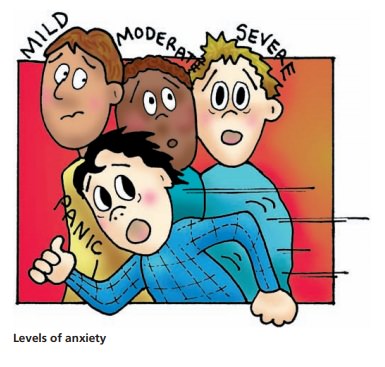Chapter: Psychiatric Mental Health Nursing : Anxiety, Anxiety Disorders, and Stress-Related Illness
Levels of Anxiety
Levels of Anxiety
Anxiety has both healthy and harmful aspects depending on its degree and duration as well as on how well the per-son copes with it. Anxiety has four levels: mild, moderate, severe, and panic (Table 13.1). Each level causes both physiologic and emotional changes in the person.

Mild anxiety is a sensation that something is different and warrants special attention. Sensory stimulation increases and helps the person focus attention to learn, solve prob-lems, think, act, feel, and protect himself or herself. Mild anxiety often motivates people to make changes or to engage in goal-directed activity. For example, it helps students to focus on studying for an examination.

Moderate anxiety is the disturbing feeling that something is definitely wrong; the person becomes nervous or agitated. In moderate anxiety, the person can still process information, solve problems, and learn new things with assistance fromothers. He or she has difficulty concentrating independently but can be redirected to the topic. For example, the nurse might be giving preoperative instructions to a client who is anxious about the upcoming surgical procedure. As the nurse is teaching, the client’s attention wanders but the nurse can regain the client’s attention and direct him or her back to the task at hand.
As the person progresses to severe anxiety and panic, more primitive survival skills take over, defensive responses ensue, and cognitive skills decrease significantly. A person with severe anxiety has trouble thinking and reasoning. Muscles tighten and vital signs increase. The person paces; is restless, irritable, and angry; or uses other similar emotional–psychomotor means to release tension. In panic, the emotional–psychomotor realm predominates with accompanying fight, flight, or freeze responses. Adrenaline surge greatly increases vital signs. Pupils enlarge to let in more light, and the only cognitive process focuses on the person’s defense.
Related Topics